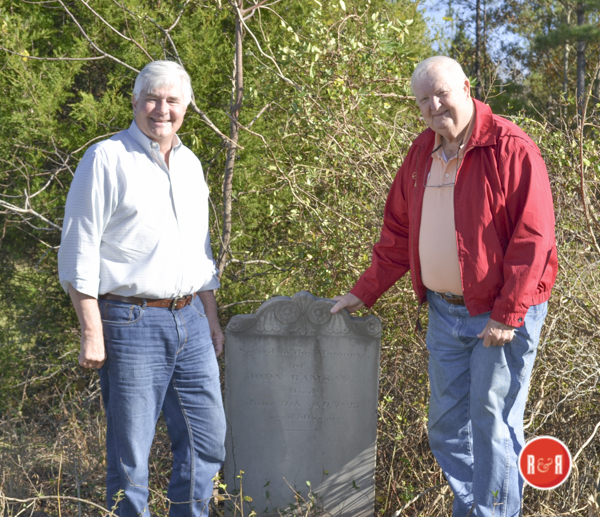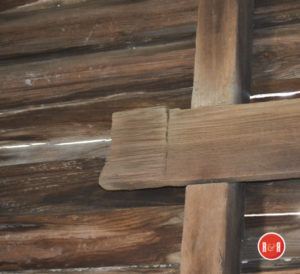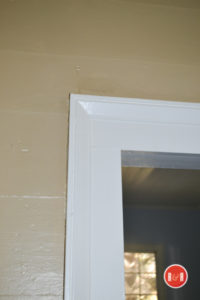
R&R’s founder, W.B. Fairey (lt), and Steve Turner of Greenwood, S.C. inspect the old Ramsay tombstone on the rear of the historic Moore-Kinard farm. 2017 (Was there a kinship with the Ramsay and Moore families? What is the tie between Mr. Ramsay and the Moore – Kinard property?)
City Directories and History: (J.M.C. Kinard House) The Moore-Kinard House is believed to have been built ca. 1835 for Wright Nicholson Moore. The house is architecturally significant as a well-preserved example of an antebellum central-hall farmhouse, or the “Carolina” I-House type. Located in the rural community of Epworth, the Moore-Kinard House is the only antebellum building remaining in the community and is the most intact antebellum central-hall farmhouse that has been identified in the county. The house is a two-story, frame, house built on a rectangular plan with a rear ell addition. Additions were made to the rear and one side of the house ca. 1900. Original wood shingles remain in place beneath the composition shingle roof, which has a boxed cornice. Moore died in 1865 but the house remained in his family until 1884 when it was sold to John Michael Calhoun Kinard and his brother William Pierce Bennett Kinard. As late as 1983 a member of the J.M.C. Kinard owned the home. Included in the nomination are the following late nineteenth or early twentieth century outbuildings: a smokehouse, cotton house, tool shed, ironing house, and well. Listed in the National Register August 4, 1983. (Courtesy of South Carolina Department of Archives and History)
Additional information: According to a Nicholson family genealogy, which was published in 1944, Wright Nicholson Moore (1811- 1865) built the house. Edgefield County land records indicate that Moore owned the land on which the house is located when he died, but do not reveal when he came into possession of the property. The fact that W.N. Moore did not appear on the 1830 federal census as the head of a household, but did appear in the 1840 census, suggests that the house might have been built between 1830 and 1840. Also, Moore reached adulthood and had children during those years. Between ca. 1835 and ca. 1875 the rural community in which the Moore-Kinard House is located was known as Phoenix. (The community was then part of the Edgefield District.) Moore’s appointment as postmaster of Phoenix in 1837 indicates that he was living in the community by that time and lends support to a ca. 1835 date of construction for his residence. In addition, construction techniques and stylistic features of the house are in accord with a ca. 1835 construction date.
According to the 1850 federal census, Moore was a farmer and the father of five children. He owned 1050 acres of land, 500 of which were improved. Moore’s livestock consisted of 70 cows, 2 oxen, 130 hogs, 70 sheep, 6 horses and 11 asses and mules; the products of his farm during the preceding year included 2,500 bushels of Indian corn, 600 bushels of sweet potatoes, 200 bushels of peas and beans, and 500 bushels of oats. Moore died in 1865, but the house remained in the Moore family until 1884 when it was sold to John Michael Calhoun Kinard and his brother William Pierce Bennett Kinard. W.P.B. Kinard, a minister, lived in the house until 1897, when he constructed a house across the road, but J.M.C Kinard, a farmer, lived in the house until his death in 1932. The Moore-Kinard House is presently owned by Frances Kinard Davis, a daughter of J.M.C. Kinard. NR File Data
- Gallery of images taken of the Moore – Kinard farm in 2017, by AFLLC including, the smoke house and its construction features.
- Note the early construction features of this smoke house, a contemporary of the main house. The sash sawn board on the side of the building shows where it was split from the mills’ carriage when it reached the end of the blade. A feature found prior to 1850 in many sections of S.C. SCROLL DOWN FOR ADDITIONAL IMAGES
Stay Connected
Explore history, houses, and stories across S.C. Your membership provides you with updates on regional topics, information on historic research, preservation, and monthly feature articles. But remember R&R wants to hear from you and assist in preserving your own family genealogy and memorabilia.
Visit the Southern Queries – Forum to receive assistance in answering questions, discuss genealogy, and enjoy exploring preservation topics with other members. Also listed are several history and genealogical researchers for hire.
User comments welcome — post at the bottom of this page.
Please enjoy this structure and all those listed in Roots and Recall. But remember each is private property. So view them from a distance or from a public area such as the sidewalk or public road.
Do you have information to share and preserve? Family, school, church, or other older photos and stories are welcome. Send them digitally through the “Share Your Story” link, so they too might be posted on Roots and Recall.
Thanks!














